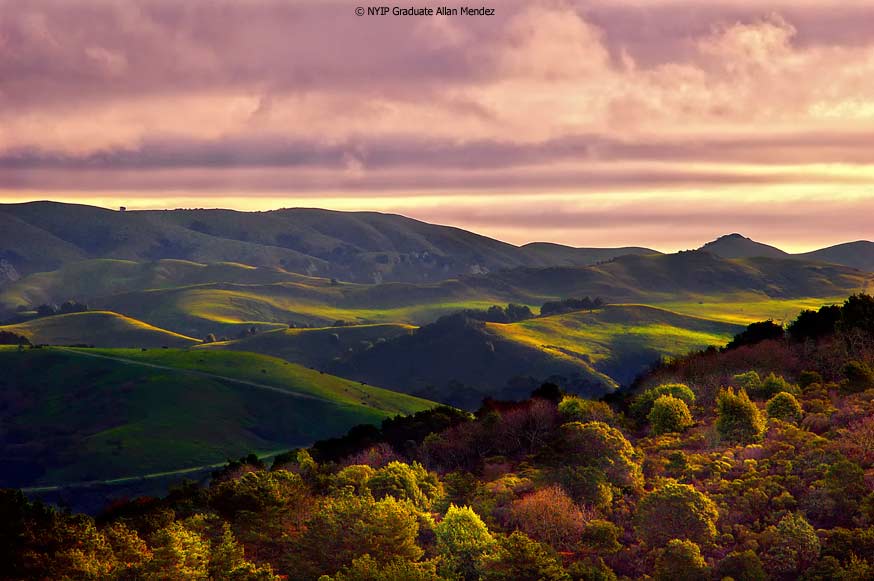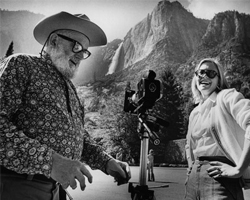Editor's Note: With this article, we're very happy to introduce our thousands of readers to a new NYIP Roving Correspondent, Frank Beacham. Frank is a journalist based in New York City who has been working with us on a project that we can't describe just yet, but his writing and interests were such that we thought he would make a great addition to our team. There's a lot going on at the Institute right now, and when Frank told us he was planning on attending the Luminance Conference held in lower Manhattan in mid-September, we asked if he could provide our readers with a report. Here's what he filed.

Donald Pettit is a chemical engineer and astronaut who, in three stays over the past decade, spent more than a year on the International Space Station. While there, he took some of the most spectacular images ever made in outer space.
Pettit worked as a scientist at the Los Alamos National Laboratory until 1996, when he was selected as an astronaut candidate. In addition to all his other skills and adventures, including a six-week expedition to find meteorites in Antarctica, Pettit is a passionate amateur photographer.

Yes, NASA trains all astronauts in photography, but doesn't assign photography duties in space. "It's more of a hobby thing," Pettit said. "There are some astronauts who-if the camera wasn't set to "P"-would never be able to take a picture. It's a personal thing for me. I enjoyed photography before becoming an astronaut and continued to grow and learn the photo equipment."

At NASA, Pettit said, the photo trainers badger the trainees by showing all of these hundreds of awful pictures that previous astronauts have taken. "They say don't take a picture like that," he said. "Up the nose shots, where you can see how many hairs are there, are frowned upon."

The problem with the above shot, Pettit said, is it's not reality. In a weightless environment, the members of the station crew are everywhere — attached to walls, on the ceiling and in coffin-sized beds in the floor. "You get used to seeing a humbo jumbo of crewmates in all these positions. So you might be looking into somebody's nose. As creatures on Earth, we are not used to seeing this. The pictures you take of your crewmates look perfectly normal to you, but when a normal picture gets to Earth, you get instructed to take pictures like this.
"Of course, you'd be hard pressed looking at that picture to know whether the group is in space or not. We only have some fancy backdrop."

Pettit likes to shoot inside the cramped spacecraft with a Nikkor 8mm fisheye lens. "We have six people living in space and an Android which we are working the bugs out of. We refer to it as him or possibly her. I've been back on earth for about two months from a 192-day space mission. We started the mission referring to the Robonaut as him and somewhere in the mission we began referring to it as her." (Big laugh from the audience.)

Among his favorite photo subjects are the approaching unmanned supply vehicles that bring food and other necessities on a periodic basic. "These are fire breathing creatures," Pettit said. "They will belch fire and I try to record these images.
"These supply vehicles dock automatically unless the automatics break down and then we have to manually dock it. They are filled full of goodies-a chamber about two and half meters in diameter. We unload all the stuff and then fill the chamber with all of our garbage, which are mostly buckets filled with poop. You gotta do something with that stuff, right? You just don't flush it. We put it in the spacecraft and undock it and it blows up in the atmosphere. So at least it's a sanitary way of getting rid of this stuff."

To take pictures outside, Pettit uses the station's Cupola, a seven window observatory module in the station that looks at Earth. It was launched aboard a Space Shuttle mission on Feb. 8, 2010 and attached to the Tranquility Node 3. The Cupola's 31-inch window is the largest ever used in space.

"We fill it with as many as eight different cameras," Pettit said. "Earth goes by really fast. You go 24,000 miles in 90 minutes. If you want to take a picture of your hometown or whatever, you have three to five seconds to get that shot. Or you'll have to wait another 11 days before you're over your hometown again. We have all these cameras set-up because there is no time to change lenses or settings. They are never turned off.

"You have this amazing perspective of Earth — you can see it on the length-scale of half a continent. It's definitely a wide angle view. If you are over central Australia, you can see the east coast and west coast at the same time. The truly unique thing through my eyes is to capture the wide angle nature of what your views are.
"We have all kinds of telephoto lenses, but if you're not careful, you get images not as good as Google Earth. In my view, you want to capture something different from what a satellite can capture."
Infrared
"I was able to talk NASA into taking a perfectly fine Nikon D3F body and pulling the IR blocking filter out. The reason is we stopped shooting film in my first flight in 2002. With that, we lost the ability to do color infrared photography. It was all film based. Now we can do infrared digitally with this modified Nikon camera.

"This is the Ganges river delta (a trans-boundary river of India and Bangladesh). The deep red is the mangrove wilderness. You can see on the left side where agriculture is starting to infringe into the wilderness area.

"This is in the Bahamas. Coral reef and turquoise water and sediments give these amazing colors in the near infrared.

"If you want to go for a jaunt outside, and we all do, you'd be better be wearing a set of clothes that look like this.
"Shadows in space are really stark.

"You are either in full blown sunlight or pitch black. There is almost nothing in between. Even when you bring the camera outside, you have these shadows you have to deal with. I sent a picture home to my boy and said we had found Godzilla in space.

"One of my favorites are star trail pictures. Nighttime doesn't really look like this, but it has all of these elements in it. These are multiple 30 second exposures stacked to show the orbital motion as well as the star trail motion. The circle is made by the pitch access of the spacecraft. These are fun pictures primarily for data."
Cities at Night
"Cities at night are fascinating. You look at how human beings sprinkle their light bulbs at night. It's amazing from an orbital perspective. Nobody on earth designs their cities by how they look to space. They just happen to turn out that way. Until 2002, all these pictures were soft focused due to orbital motion.

"I was unhappy about that. So I cobbled this piece of equipment up with spare parts that were on the space station. The big black thing is an IMAX movie camera mount. It wasn't being used because we no longer had film on the station. So I figured no one would mind if I used it. I got out our drill driver. I needed a long bolt. I found one in the progress vehicle. I figured no one will miss just one bolt." (More laughter.)
"So you drive that bolt and it pushes against the platform and you can move one axis of a gimbal in a controlled manner depending on how much you squeeze the trigger. I took a Hasselblad camera with a 70 mm film back, though we had no film anymore. I put the 350mm lens on it. It became a fancy spotting telescope. You look through that camera and squeeze the trigger on the drill driver until the images are stationary and then you take a picture with the other camera mounted on the mount.
"If you're an amateur astronomer, you realize this is nothing more than a barn door tracker. Barn door trackers are used to take pictures of space to counter Earth motion. I was in space countering orbital motion so I could take a picture of Earth.

"Times have changed. The space agency has built a computer controlled tracker. This is New Orleans taken from the mission I just got back from. Taken with a Nikon D3F we can now get down to 10 meter resolution. You can see the Mississippi River and the French Quarter and see it's a pretty hopping place at this time of night."
Pettit said it turns out there is a triangle between culture, technology and geography that dictates how humans move lighting around. One can see different types of lighting by region, he said. "Embedded in this data about our cities is something about who we are as a species. Cities at night may be one of the most beautiful unintentional consequences of human activity."
Pettit was asked if he had ever used Photoshop on his images while in space. "Most images are downloaded from space. During my mission, we had six hard drives fail. Hard drives somehow fail when they get into weightlessness. They don't last like they do on Earth. Nobody understands why, but they just do.
So the quicker you can get your images off of a hard drive and downloaded, the better. NASA does a good just of ferreting out all the RAW files, which are stored as NEF files. I do hold some of my favorites and I do have a copy of Photoshop and I work with some of them in my spare time just because I can.
But I'd rather spend my time taking the pictures while in orbit than doing image processing. You have plenty of time to do that when you're back on Earth."
Finally, with all the usage of his images being manipulated on YouTube, Vimeo and Facebook over the past year, Pettit was asked if had ever seen them online and what is his opinion.
"I have seen many of these time lapse movies and it does me good that people are actually using the pictures that I take," he said. "I think whatever art form you enjoy creating the best compliment is to see somebody take it and enjoy it themselves. At NASA, I can't use copyright music unless we can arrange with the musician. But people on YouTube do that. So they make these marvelous film clips that I can't do. Some of these are so beautiful, it brings a tear to my eye."

Some of the most beautiful photographs in the world come from outer space. That is why NASA trains all it's astronouts in photography. Come learn photography with NYIP today!






